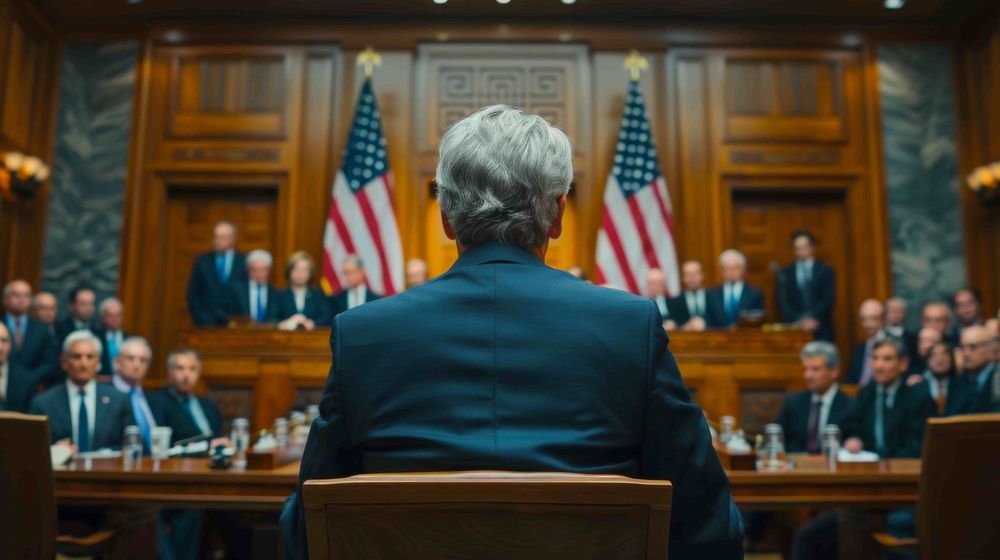For months now, an open conflict has been simmering between US President Donald Trump and Jerome Powell, the Chairman of the US Federal Reserve. This week, speculation has intensified that Trump may seek to dismiss Powell before his term officially ends in May 2026. Such a move could threaten the independence of the Federal Reserve and pose significant risks for financial markets.
Donald Trump himself appointed Jerome Powell as Fed Chair during his first term, and Powell’s tenure is scheduled to last until May 2026. Trump has repeatedly criticized the Fed’s interest rate policy, attacking Powell both publicly and personally. He has accused Powell of pursuing a policy that is too restrictive, which President Trump claims hampers economic growth and his political agenda. In recent months Trump has further escalated his rhetoric, openly discussing Powell’s possible removal. However, the legal leeway to do so is extremely limited: a Fed Chair can only be dismissed for serious reasons such as misconduct, breaking the law, or inability to perform official duties, a high bar intended to safeguard the central bank’s independence.
New allegations? Fed headquarters renovation costs in focus
Trump is therefore accused of actively seeking pretexts to remove Jerome Powell from office. Most recently, he and his circle have focused on rising costs for the renovation of the historic Fed building in Washington, D.C. The project, initially budgeted at USD 1.9 billion, now stands to cost roughly USD 2.5 billion. Trump suggested this week that Powell could be dismissed over this cost surge, stating to reporters that Powell’s handling of the project “might be” grounds for termination. Powell firmly rejected this notion, reiterating that such a dismissal is not permissible under the law.
Powell’s monetary policy and Trump’s criticism
Trump has long demanded a much more expansionary monetary policy. Specifically, he is pushing to lower the key policy rate from its current 4.50% to around 1%-1.5%. This could briefly spur US economic growth, weaken the dollar, and thus improve the international competitiveness of the US economy. Such rate cuts would also ease the enormous and growing debt service burden of the US government.
Powell and the majority of the monetary policy committee (FOMC) reject Trump’s demands due to perceived inflation risks arising from US tariff policy, fearing that hasty rate cuts could undermine confidence in the Fed. The US inflation rate currently remains at around 3%, still above the 2% target range, which supports Powell’s cautious stance.
Fed decisions: More than a one-man show
It’s important to note that the Federal Reserve’s monetary policy is not determined by the Chairman alone. Interest rate decisions are made by the Federal Open Market Committee (FOMC), a collective body with twelve voting members. Although the Fed Chairman has considerable influence on policy direction and public communication, final decisions are not made unilaterally.
This week’s speculation over a possible dismissal of Powell caused a brief stir in the financial markets on Wednesday. After initial volatility, Trump backtracked somewhat, saying he “currently had no specific plans” to remove Powell from office. Markets quickly recovered.
Nevertheless, uncertainties remain. Many market observers see Trump’s comments as a “trial balloon” to test market reactions. If Powell were to be dismissed, it could trigger pronounced volatility and a loss of confidence in the stability of the Fed.
Political calculations carry risks
The Trump administration’s agenda has now become clearer: overheat the economy, introduce further fiscal stimulus, and exert constant pressure on the Fed to lower rates. The aim is to generate additional economic stimulus, weaken the dollar, and reduce the interest burden on US debt.
Under such circumstances, asset classes with some inflation protection—such as stocks of companies with strong pricing power, gold, or commodities—have typically performed well. However, past comparisons are not fully applicable in a worldwide environment with trade wars, attacks on Fed independence, or adversarial global policies.
Powell’s regular term will end in less than a year. Dismissing him shortly before next year’s midterm elections could backfire for Trump, as financial market turbulence could hurt economic growth. Any short-term benefits of aggressive rate cuts would likely be outweighed by a loss of market confidence and higher volatility.
Why this conflict also directly affects Swiss investors
The US Fed is the world’s most important central bank, influencing not only the US economy but also global financial markets and economies. Its decisions directly impact interest rates, currencies, and investment flows, affecting economic stability and development in many countries – including Switzerland. The Fed’s independence is crucial for making objective, long-term decisions based on economic data, which in turn supports confidence in the financial markets.
How might financial markets react to Powell’s dismissal?
It is impossible to predict Trump’s agenda or the exact response of global financial markets. However, markets would likely react with volatility in the short term, interpreting such a move as an attack on the Fed’s independence.
A crucial factor would be Powell’s successor: If a recognized and experienced professional was nominated, a major correction may be avoided. The real concern is the risk of a politically motivated selection favoring a much more expansionary monetary stance.
Possible short-term reactions:
- Significant volatility in financial markets
- Increased inflation risks
- Equity markets under pressure in both the US and globally
- Weaker dollar due to prospects of more expansionary monetary policy and weaker confidence in institutional stability
- Increased capital outflows from the US – Europe and emerging markets could be the beneficiaries
- Gold and the Swiss franc would likely benefit as safe havens
- Even Bitcoin could benefit – not only as a digital asset, but also as an alternative to the traditional financial system. In fact, Bitcoin was created in response to a loss of trust in central institutions after the financial crisis of 2008
What does this mean for Swiss investors?
First and foremost, it is advisable to maintain a strategic position. Reacting hastily to unclear developments could jeopardize long-term investment objectives. It is prudent to adhere to a carefully considered investment strategy that emphasizes diversification and aligns with individual financial goals. A disciplined approach enables investors to navigate periods of uncertainty more effectively.
Should investment plans be suspended or portfolios sold?
No. As outlined above, it remains advisable to maintain a well-structured investment strategy that emphasizes diversification and aligns with personal financial objectives. Potential market corrections can present attractive buying opportunities—particularly for optimizing entry prices of existing long-term positions. Hasty action should be avoided.
What portfolio adjustments make sense for a CHF-based portfolio?
For investors with excess equity allocations – especially in US dollar assets – it may be wise to review and reduce these positions as appropriate. CHF-hedged gold positions can be considered as safe-haven assets. US government bonds are less suitable for this purpose, as the hedging costs for USD into CHF result in unattractive yields.

